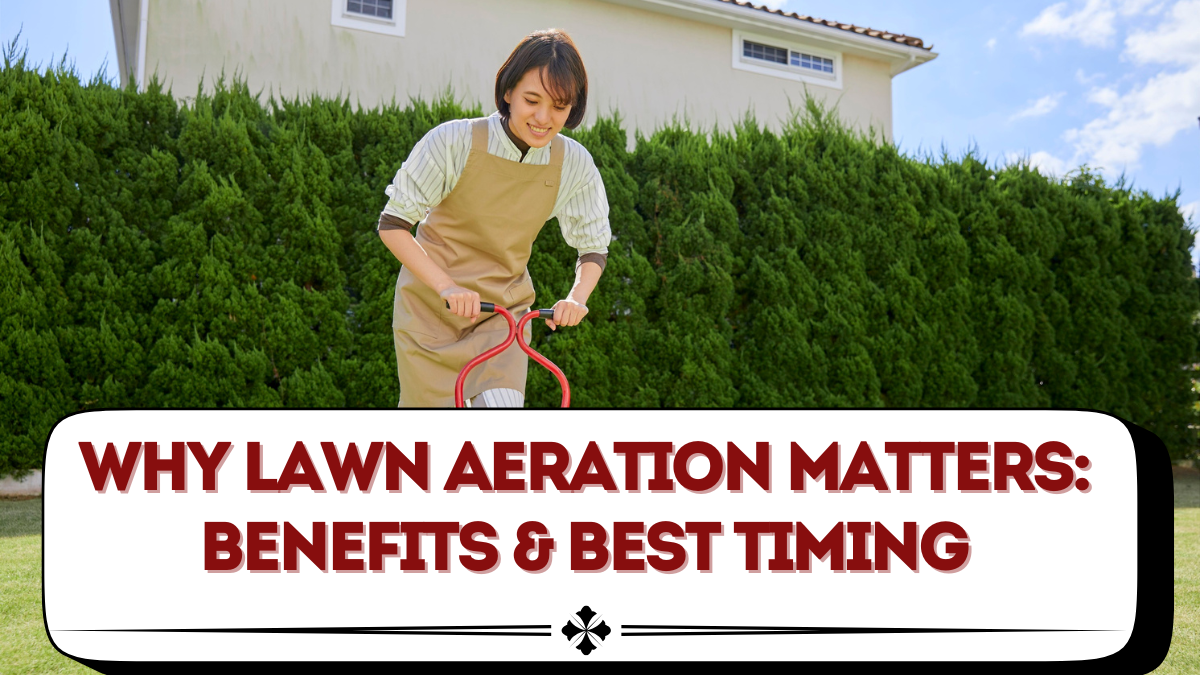A green, vibrant lawn is the pride of many homeowners, but even the best watering and fertilization plans can fall short if the soil beneath is unhealthy. One of the most overlooked yet powerful lawn care practices is aeration. It may not seem as essential as mowing or watering, but it plays a crucial role in maintaining healthy soil and strong root systems. The true lawn aeration benefits go beyond just loosening compacted soil; aeration enhances nutrient absorption, improves drainage, and prepares grass to thrive in every season.
This article explains why aeration matters, the different methods available, and the best timing for the process so you can maximize your lawn’s health.

What is Lawn Aeration?
Lawn aeration is the process of perforating the soil with small holes to allow air, water, and nutrients to penetrate the grass roots. Over time, soil becomes compacted due to foot traffic, mowing, and environmental factors. Compacted soil restricts the flow of essential elements, leaving roots starved and grass weak.
By aerating, you create channels for oxygen and water, helping grass roots grow deeper and stronger. The result is a lawn that looks greener, resists drought better, and recovers faster from stress.
Key Lawn Aeration Benefits
Aeration provides a wide range of advantages for lawn health. Some of the most important benefits include:
-
Improved Nutrient Uptake – Fertilizers and organic matter reach the roots more effectively.
-
Better Water Absorption – Aerated soil prevents runoff and promotes even moisture distribution.
-
Deeper Root Growth – Stronger roots lead to healthier, more resilient grass.
-
Reduced Soil Compaction – Allows roots to expand freely and absorb essential elements.
-
Enhanced Microbial Activity – Increases beneficial soil organisms that aid in lawn health.
-
Faster Recovery – Lawns bounce back quicker from heavy use, droughts, and heat stress.
For homeowners struggling with patchy or weak lawns, aeration often proves to be the missing link in their lawn care routine.
Types of Lawn Aeration
There are two main aeration methods, and choosing the right one depends on soil condition and lawn size.
1. Spike Aeration
This method uses solid tines or spikes to create holes in the soil. It is easy to do and suitable for small lawns but may compact the soil further in heavy clay soils.
2. Core (Plug) Aeration
Core aeration removes small plugs of soil, which reduces compaction more effectively. It is considered the most beneficial form of aeration for medium to large lawns and clay-heavy soils.
| Aeration Method | Best For | Effectiveness | Cost |
|---|---|---|---|
| Spike Aeration | Small lawns, sandy soil | Moderate | Low |
| Core Aeration | Large lawns, compacted clay | High | Moderate |
| Liquid Aeration | Any lawn, eco-friendly option | Medium–High | Varies |
Liquid aeration, which uses soil-conditioning solutions, is also gaining popularity as an eco-friendly, low-effort alternative.
When is the Best Time to Aerate?
The timing of aeration is critical for success. Aerating during the wrong season may stress grass instead of strengthening it.
-
Cool-season grasses (fescue, ryegrass, Kentucky bluegrass) should be aerated in early spring or early fall, when growth is most active.
-
Warm-season grasses (Bermuda, Zoysia, St. Augustine) should be aerated in late spring through summer during peak growth.
Avoid aerating during dormancy or extreme heat, as lawns may not recover properly.
Tips for Effective Aeration
To maximize results, combine aeration with other lawn care practices.
Practical tips include:
-
Water your lawn the day before aeration to soften the soil.
-
Aerate high-traffic areas more frequently, as compaction is greater there.
-
Leave soil plugs on the lawn; they break down and return nutrients to the soil.
-
Overseed and fertilize immediately after aeration for better results.
-
Repeat aeration annually or biannually depending on soil type.
Combining aeration with overseeding ensures that new seeds settle deep into the soil, creating a thicker, healthier lawn over time.
FAQs
How often should I aerate my lawn?
Most lawns benefit from aeration once a year, but heavily compacted soils may require aeration twice annually.
Can I aerate my lawn myself?
Yes, homeowners can rent aerators or use manual tools. For large lawns, professional services are recommended for efficiency.
Should I fertilize after aerating?
Yes, fertilizing after aeration helps nutrients penetrate deeply into the soil for stronger root development.
Is aeration necessary for sandy soil lawns?
Sandy soils don’t compact as easily, so aeration is needed less often. Clay-heavy soils benefit the most from regular aeration.
What’s better: spike or core aeration?
Core aeration is more effective because it removes plugs of soil, reducing compaction significantly compared to spike aeration.
Conclusion
The lawn aeration benefits are undeniable. By reducing soil compaction, improving nutrient uptake, and promoting stronger root growth, aeration is one of the most powerful steps you can take for a healthier lawn. The best results come when aeration is timed according to grass type and paired with overseeding and fertilization. Whether you choose core, spike, or liquid aeration, this practice ensures your lawn stays greener, thicker, and more resilient year after year. If you want a lawn that thrives in every season, aeration is not optional—it’s essential.
Click here to know more.
